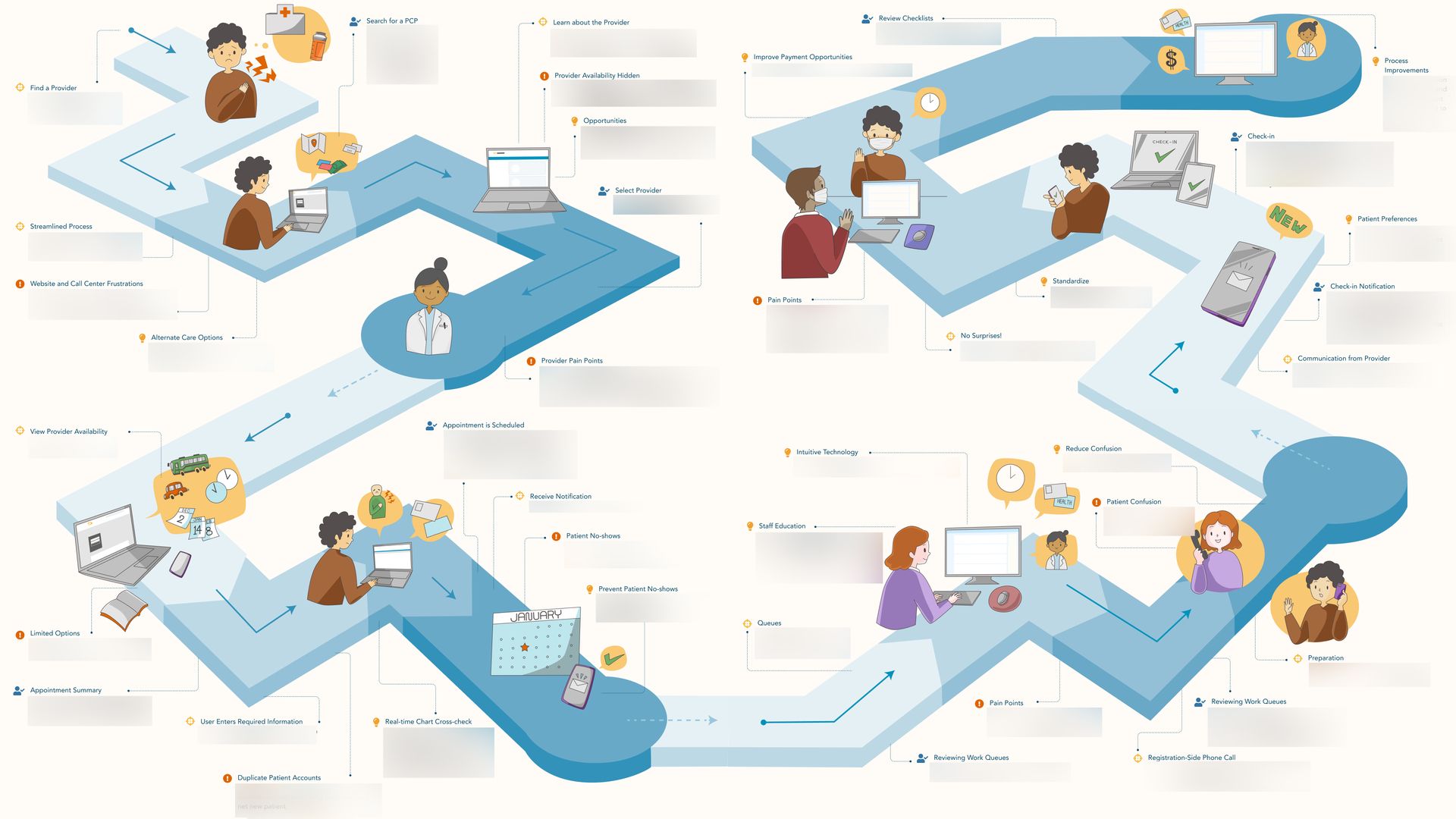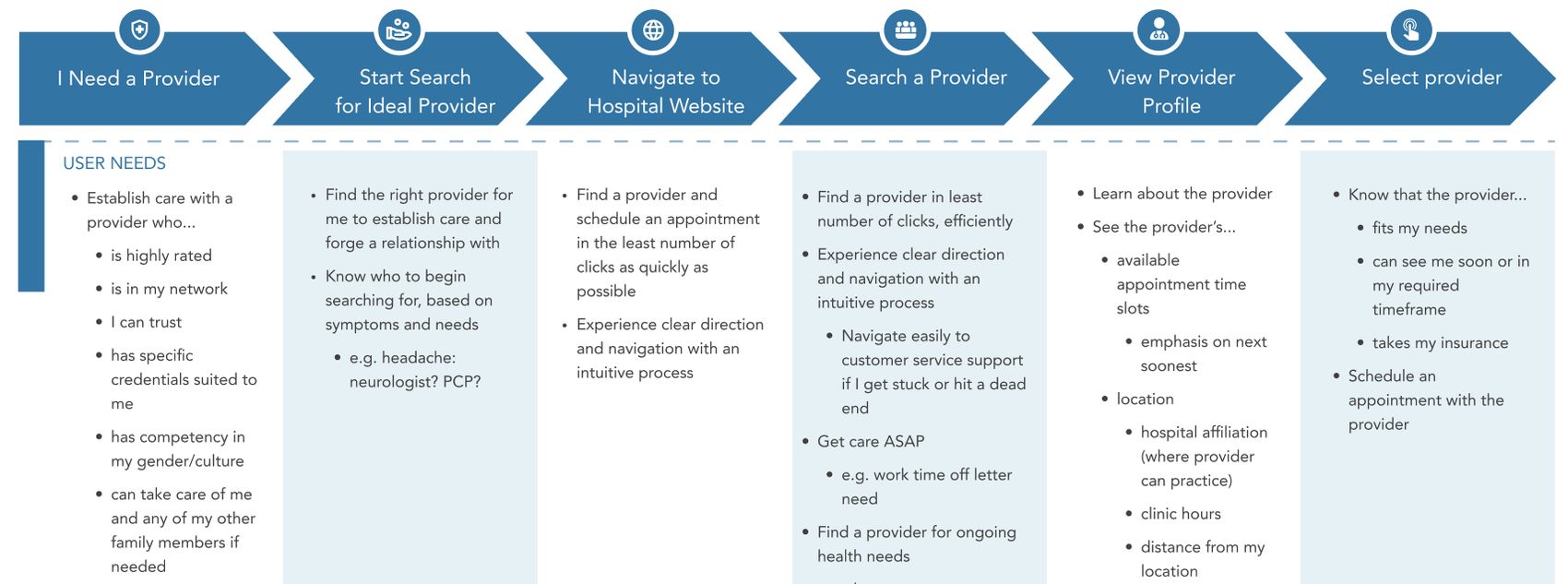
User Journey Mapping & ROI:
Did you know that journey maps are shown to increase business ROIs by 13-22%? (Source) It’s easy to see why: user journey mapping forces stakeholders to take a deep dive into every step that a user takes during their use of a product. This simple exercise is a game changer for designing the best solutions for your users.
User journey maps (or customer journey maps) are a visual representation of a user’s steps throughout their experience. This artifact is like a user flow on steroids: each step is given a high level of detail. We include user journey maps as a hallmark deliverable of our Strategy & Design engagements because they have important, crucial benefits:
- Uncover every step of the user’s journey
- Visualize the end-to-end experience of the user
- Facilitate stakeholder alignment with transparency into the user’s experience
In our process, user journey maps come after crafting user personas (check out our User Persona blog here!) and before our user story mapping exercise. It’s important to first understand the user before mapping out their journey, and then designing the right solutions and features for them becomes much easier.
Here are our favorite parameters for a user journey map:
User: the specific user persona for which you will be evaluating the journey.
Scenario: the scope and timeframe of the journey.
- By establishing a scope and timeframe of your user’s experience, it is much easier to dial in on specific, near-term, attainable improvements to add to your backlog.
Columns: each individual step of a user’s journey.
- We like to say that a user’s journey starts before they even think of interacting with your software and ends way after logging out. “Steps” can be defined however makes the most sense for your users, but a good measure is if you can provide enough detail for every row in your journey map.
Rows: categories for which you will evaluate every step of a user’s journey.
- User Goals/Needs
- What are the user’s goals of this step?
- What would they like to accomplish by doing this step?
- Why are they doing this step?
- What do they expect this step to be like?
- Process
- What actions might the user take in order to complete this step?
- Are the actions variable depending on the user type, or does every user have to complete the same actions in the same way?
- e.g. Is the user required to fill out 85 free-text fields, or are they reviewing the date and time for which they scheduled their appointment?
- Channels/Touchpoints
- Which other pieces of software does the user interact with in this step?
- Does this step require face-to-face interaction?
- Does this step require a user to call someone for a conversation via a phone?
- Can a user complete this step on both the web and a mobile device?
- Experience
- This category can help determine which steps frustrate users most and may need extra consideration when designing.
- What emotions does the user experience while they complete this step?
- Is this a step that the user wishes they didn’t have to do, or is it a step that the user enjoys to do?
- Problems/Pain Points
- What blockers may the user run into during this step?
- What may users not like about this step?
- How might this step negatively affect other steps earlier or later in the journey?
- Ideas/Opportunities
- What are ideas for how to eliminate the pain points that were identified for this step?
- Is this step needed, or can it be combined with another step in the journey to streamline the overall process?
- What features could be added or what could we do differently to improve the user’s experience of this step?
Facilitation: user journey maps should be a facilitated exercise with a range of stakeholders.
- Attendees of user journey mapping sessions should at least involve SMEs of your product, but it can also be helpful to invite secondary stakeholders for diverse opinions, thoughts, and ideas. To facilitate these sessions, we designate one facilitator and one notetaker and walk through each cell one at a time. (UXPRESSIA is our tool of choice for user journey maps!)

We’ve heard horror stories of (and experienced) businesses spending a lot of time and money for user journey maps to be developed, printing out the final deliverable, hanging it on their walls, and then only using them as an art piece. User journey maps done correctly are ripe with information. As an example, we take the bullet points in the Ideas/Opportunities row and add them each as a sticky note in a user story map: the next step of our process. Then, these are directly translated into tickets for your product backlog. Take the time to take the journey WITH your user!
by Morgan Brown

